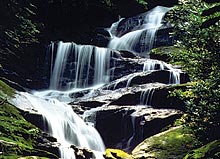In our technologically advanced nation, most of us take for granted an instant and copious stream of clean water from the moment we turn on our faucets. But in the backcountry, getting water—especially clean water—can present a host of challenges.

Though invisible to human eyes, harmful bacteria, viruses and parasites are often present in water—microscopic nasties that are only too happy to slide down the throats of innocent consumers. Take, for instance, the hiker who refills his water bottle in an open stream, or the dehydrated trail runner who laps from a waterfall at mile 20. However pristine they may look, cautions wilderness-medicine expert Andrea Gravatt, “Such waters—and other open waters like ponds and rivers—are often infected by both human and animal wastes and laden with infectious agents.”
Without treatment, people ingesting such water-borne pathogens as Escherichia coli, salmonella and Campylobacter jejuni can become severely ill or even die—especially the young. Viruses, too, may lurk in water, including rotavirus, norovirus and hepatitis A.
In most cases, boiling water, or treating it with iodine or chlorine, kills bacteria. As a rule of thumb, most pathogens are killed within seconds once the water comes to a rapid boil. As an extra precaution, boil for one minute under normal circumstances, and three minutes at high altitudes. To be effective against bacteria, chlorine drops or household bleach need 30 minutes to do their work, and longer if the water’s very cold. Add four drops of chlorine or household bleach per liter.
Many filters are also advertised as being effective against bacteria. Because of their small size, however, viruses can slip by some filters, cautions Gravatt. “Boiling water kills viruses, and both chlorine and iodine are effective against viruses,” Gravatt says.
And there are parasites along the trail, as well. Two of the more common ones are Giardia lamblia and Cryptosporidium parvum. Giardia, which is found in the stools of dogs, cats, rodents and wild animals, is quite common and can infect any water source those wastes contact. Symptoms of giardiasis include explosive, watery diarrhea; abdominal cramps; vomiting and fever; nausea and belching. Fatigue, anorexia and weight loss are not uncommon. Complicating matters is the fact that symptoms can take one to two weeks to set in.
Eli Day contracted giardia while through-hiking the Appalachian Trail’s 2,000-plus miles. “It sucked,” he recalls. “I got really tired, had body aches and barely made it to camp that night. I was already carrying the antibiotic of choice, having had E. coli before. I started self-medicating, and my GI stuff cleared up a day later. That was probably the hardest 10 days on the trail, as I didn’t dial back my mileage at all.”
Erich Pearson recalls a furious two-year bout with giardia. “I would get violently, miserably ill about every four to six months,” he says. “Eventually, the bugs and my immune system reached a truce. Trust me: Avoiding even one of those bouts is worth all the expense and bother of a lifetime of backcountry water treatments.”
Although iodine and chlorine are effective against most cysts and parasites, cold water necessitates longer contact with these agents (90 minutes). And because of its resistance to these halogens, Cryptosporidium requires the use of an additional treatment, i.e. boiling or filtration.
A rule of thumb holds that outdoors enthusiasts will require roughly three liters of water per person on a one-day excursion. Ultra-runner Mike Piercy packs his water in. “My CamelBak (a pack complete with a bladder) holds three liters, and if I manage my consumption, that is enough for 6 to 6.5 hours [of trail running].”
But if your trip takes you into the wilds for more than a day, you’ll need to have a way to make your water safe. At the low end, a bottle of bleach costs a few dollars, and iodine tablets run about 50 for $5. Mechanical filters are a pricier option. The MSR Sweetwater charcoal filter pump churns out one liter per minute, treats up to 200 gallons of water with a single filter, and costs about $65.
“I have used the MSR pumps that fit on top of a Nalgene bottle, and they really work well,” says Adam Hill. “It’s amazing how they filter out the dirt and particles from the stream. They don’t change the taste of the water and really are a big help; they make the camping a lot more enjoyable. When you hike 15 miles in the woods, knowing that you only have to take a pump is much easier than carrying gallons of water.” (That’s assuming you can find water to filter, of course.)
Another, newer technology uses ultraviolet light to kill viruses. The SteriPen Hydro-Photon takes about 1.5 minutes to sterilize a liter of water (you just insert the light tube into a water container and push the button to fire it up) but it costs about $79, though the price has come down from when the gadget came out a few years ago.
And whatever you spend, a good plan is worth having, so you can save your guts for the adventures ahead.
[Jonathan Poston leaves for China later this month. We say “zai jian” and thanks for all the good times.]



How do cysts relate to safe water?